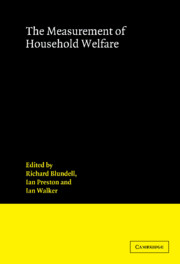Book contents
- Frontmatter
- Contents
- List of contributors
- 1 An introduction to applied welfare analysis
- 2 Measuring the cost of children: a theoretical framework
- 3 The collective approach to household behaviour
- 4 Ordinal and cardinal utility: an integration of the two dimensions of the welfare concept
- 5 The determination of welfare in nonintact families
- 6 Female labour supply, housework and family welfare
- 7 Engel equivalence scales in Sri Lanka: exactness, specification, measurement error
- 8 Measuring the life-cycle consumption costs of children
- 9 Family fortunes in the 1970s and 1980s
- 10 Ethically-consistent welfare prescriptions are reference price-independent
- 11 The effect of systematic misperception of income on the subjective poverty line
- Index of names
- Index of subjects
8 - Measuring the life-cycle consumption costs of children
Published online by Cambridge University Press: 13 January 2010
- Frontmatter
- Contents
- List of contributors
- 1 An introduction to applied welfare analysis
- 2 Measuring the cost of children: a theoretical framework
- 3 The collective approach to household behaviour
- 4 Ordinal and cardinal utility: an integration of the two dimensions of the welfare concept
- 5 The determination of welfare in nonintact families
- 6 Female labour supply, housework and family welfare
- 7 Engel equivalence scales in Sri Lanka: exactness, specification, measurement error
- 8 Measuring the life-cycle consumption costs of children
- 9 Family fortunes in the 1970s and 1980s
- 10 Ethically-consistent welfare prescriptions are reference price-independent
- 11 The effect of systematic misperception of income on the subjective poverty line
- Index of names
- Index of subjects
Summary
Introduction
The costs of children can be seen as the additional expenditure needed by a household with children to restore its standard of living to what it would have been without them. To implement this, one might think of comparing the expenditures of two households, one with and one without children, yet sharing a common level of welfare. As documented in a number of studies in this volume, the difficulty in this is in finding a criterion which might allow one to identify when two households of different composition are at a common living standard. While economic analysis of expenditure behaviour can provide important information on the way household spending patterns change in response to demographic change, it cannot identify preferences over composition itself and cannot identify costs of children without making assumptions about these preferences (see Pollak and Wales, 1979; Blackorby and Donaldson, 1991, and chapter 2 in this volume; Blundell and Lewbel, 1991, for example). We argue below that the placing of welfare measurement in an intertemporal context widens the set of parameters that we can identify and clarifies the nature of the welfare information that cannot be recovered from consumer behaviour. Quite simply, consumption changes over time following a change in demographic structure probably come closest to reflecting the consumption costs of children.
If intertemporal substitution responses are allowed for then the usual practice of measuring costs by concentrating on effects of children upon the within-period composition of spending seems unappealing.
- Type
- Chapter
- Information
- The Measurement of Household Welfare , pp. 192 - 214Publisher: Cambridge University PressPrint publication year: 1994



